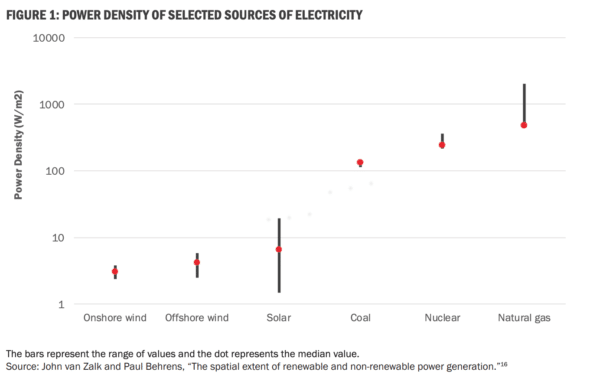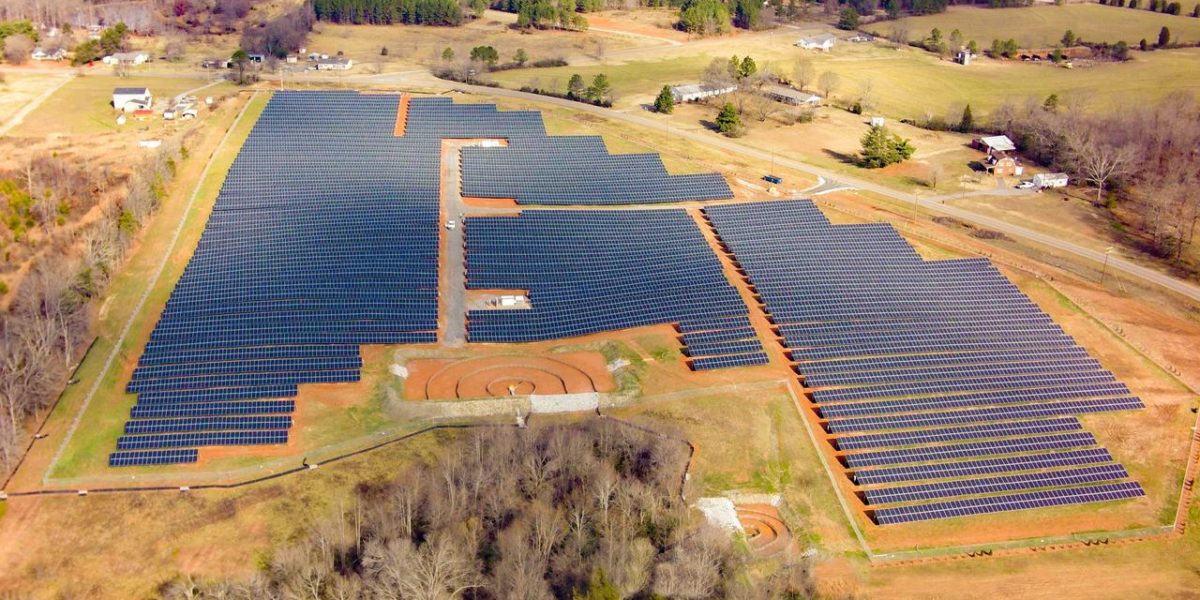As anyone familiar with the saga of the Spotsylvania solar project knows, an inherent difficulty in developing renewable energy projects comes in finding the right project location, both in terms of size and siting.
This is one of the topics analyzed in a new report released by The Brookings Institute: “Renewables, land use, and local opposition in the United States.”
It’s a hard fact that renewable generation uses more land than fossil fuel systems, with solar having slightly lower median land use than both on- and offshore-wind, despite a large variance in total land density values.

While this presents an issue for renewable developers, the silver lining is that renewable energy can be sustained indefinitely on the same land base, while mines and wells will eventually run out. As a solution, the study recommends greater development on brownfields, as well as floating PV, though the authors do recognize the capped potential of floating PV at around 10% of current U.S. electricity generation.
What the study recognizes as a bigger issue is the need for new transmission infrastructure in the United States and the “chicken-and-egg problem” with renewables that this creates. As the report puts it:
Without adequate and accessible transmission capacity, renewable projects are less likely to be economically viable, but investments in renewable energy are needed to justify construction of new transmission.
What the report boils down to is that, for solar power and renewable energy as a whole to meet future mandates and become a driving force in the U.S. energy sector, work will have to be done in order to guarantee that land and public approval can be attained.
As stated above the first and easiest solution outlined is to develop renewables on low-conflict land, like brownfields, as well as in areas where the projects will have little interaction with humans, like in the Great Basin. However this is not a cure-all, as brownfield sites, like floating PV sites, are limited and investing heavily in renewable projects in the desert would require massive transmission investment and installation, taking up populated land, potentially causing local opposition.
The report recommends combining solar systems with agriculture: mounting solar panels on stilts to allow standard agricultural machinery to work beneath the installation. This could provide a net benefit not just to developers, who get access to more land, but farmers, as shading from the panels could “produce higher yields during times of drought stress, due to lower water transpiration through the leaves and a reduction in heat stress.” Financially, farmers would be compensated for the use of their land, which the report suggests could drive down food prices.
However, at some point there will be projects like Spotsylvania, where the intersection of daily life and renewable generation are unavoidable. In these instances, the authors of the report see local cooperation and strong laws as the necessary components to symbiosis.
As the report outlines, there’s no better alternative for attaining public favor than getting to know the community and addressing the concerns of residents. “Best practices include establishing an ongoing dialogue with external stakeholders, understanding who represents the community and not dealing exclusively with the loudest or most powerful members, and considering global and local concerns together.” The understanding has to go both ways, however, or projects will end up being developed solely in areas where opposition isn’t loud or areas with little political sway.
As for solutions that are politically and policy-driven, areas can look to improve their planning and zoning laws. Specifically, these areas could clearly define siting requirements for renewable generation and transmission and declare particularly sensitive areas off-limits, as well as establish renewable energy zones for ease of development.
Nationwide policies that encourage and promote rooftop solar installations also take a huge chunk out of the overall land needed for a shift towards renewable generation. The authors argue that “Commercial and residential installations of rooftop solar are likely to cause less backlash and are more appropriate for crowded or protected settings.”
This is an issue that goes deeper than just communal opposition, though, and is frequently influenced (negatively) by local utilities, adding another layer to the required amount of cooperating parties in the renewable transition.
This content is protected by copyright and may not be reused. If you want to cooperate with us and would like to reuse some of our content, please contact: editors@pv-magazine.com.









I would suggest a different solution . It would not require new transmission
line infrastructure. Distributed solar on some small % of the customers serviced by a particular utility. 100-500kw systems installed on a right of way on the customers land ( who volunteered to have it installed on their property). Utility would pay customer for kwh produced separate from their normal utility bill. Grid tie point would be right there where customer is connected to grid. many advantages :no line losses,
potential for tracking, potential for storage,etc.
How many parking lots are in the blazing sun? What would it take to put up PV pergolas?
Keeps the cars cool and dry. Easy access for repairs.
Good thinking Ken, now go a little more out of the box and think ROW’s alongside freeways. Testing of how far to set-back from actual traffic for road spray, visibility, and vehical safety would have to be verified, but transmission lines very often already follow public highways. These areas are also very often already wildlife compromised and vegitation control costs taxpayer money, an expense that would shift off the public pocket book.
Another classification of lands that could be studied is Marsh/swamp/partially inundated lands termed “unproductive lands” or “wetlands”. These are not so much “floating solar” but racking on piers augerred into the bed.
Park and rides, and company parking lots where daytime parking is most used it the absolute best. The coming EV explosion will make charging and power back up for companies a win-win for employees selling their storage capacity to companies looking to green or peak-shave. Even PPA their employees’ home solar.
The problem is they want big farms when what is needed is millions of smaller generation on already used land close to/at the load.
There is little need to use virgin/farm land for solar as in 15 yrs everyone will have solar too on most homes, buildings as so cheap.
Roof tops seem to have greatest potential in my opinion. Some other thoughts are ski resorts especially those on public land and golf courses.
Large parking lots, build a superstructure to support panels so traffic could flow underneath.
With the possibility of carbon tax give green house emitters a chance to designate areas for wind / solar(tank farms at oil refineries comes to mind)
Mentioned earlier our interstate right of way.
Just thoughts by a very interested person.